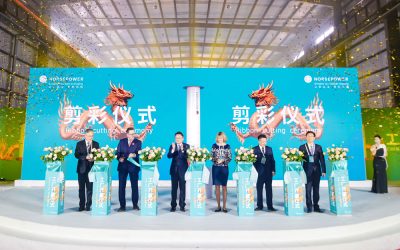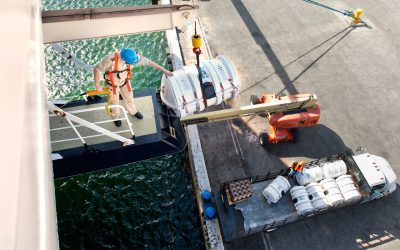New regulations, price challenges for existing and new fuels along with the growing pressure from cargo owners to reduce Scope 3 emissions are driving an increased deployment of wind propulsion technologies, writes Gavin Allwright
In 1860, just before he became president, Abraham Lincoln gave a speech featuring one of my favourite quotes regarding wind power.
“Of all the forces of nature, I should think the wind contains the largest amount of motive power … And yet it has not, so far in the world’s history, become properly valued as motive power. It is applied extensively and advantageously to sail vessels in navigation. Add to this a few windmills and pumps and you have about all. As yet the wind is an untamed, unharnessed force, and quite possibly one of the greatest discoveries hereafter to be made will be the taming and harnessing of it.”
He was, of course, correct. Though it took over a century for modern wind turbines to start harnessing this inexhaustible, abundant and free energy source on the land.
Unfortunately, while harnessing the energy of the wind took off, the previously favoured use of wind energy by ships tailed off and eventually disappeared in all major maritime sectors apart from the leisure and racing worlds.
The good news is that this maritime trend is now being reversed. However, as with any new technology adoption or energy transition there is the need to deliver on three main pillars which build a foundation of trust in the systems and solutions:
- Robustness and Safety
- Validation and Viability
- Economic and Accessibility
The need for standards sits as the base stone to these pillars but also there must be a challenge to unfounded or outdated positive perceptions of the existing system and of course challenging the negative perceptions of the incoming or disruptive approaches and solutions. All of these matter when it comes to the adoption of wind propulsion systems and each of these foundation pillars are in varying stages of development, as you might expect.
The upcoming Wind Propulsion Conference hosted by the Royal Institution of Naval Architects, in association with the International Windship Association (22-23 October, IMO HQ, London), will have an extensive range of papers tackling many of the issues in the first two categories, focusing on the first two pillars which encompass design, technology, operations and standards. These two pillars then lay the groundwork for tackling the third pillar, the supply chain, business models and economic challenges that are required to further accelerate that scaling process.
If we tackle that third pillar first and ask, where exactly are we on the innovation dissemination curve? As we go to print there are 45 wind propulsion solutions installed on commercial vessels of sizes over 400gt across almost all the main sectors of shipping. This amounts to over three million deadweight tonnes of shipping capacity. Alongside this growing wind use there are 10 ‘wind-ready’ vessels, i.e. those with all of the foundation work completed but without the wind propulsion technologies components installed. This wind powered fleet is further complemented by 10 traditionally rigged small cruise vessels and a dozen or so small sail cargo vessels under 400gt in addition to indigenous sail fisheries and cargo vessels operating in the Indian Ocean and Pacific etc.

MOL has continuously measured the performance of its proprietary Wind Challenger system on bulker Shofu Maru since its delivery in October 2022, confirming fuel savings of up to 17% on its voyages. The company plans to launch 25 vessels equipped with the system by 2030. Source: MOL
Large wind-powered vessels are primarily to be found in the bulker, tanker, ro-ro and general cargo segments and the total number is likely to double over the next 12 months. If the pipeline of orders continues with the current trends, the number of wind installed vessels will at least double each year going forward. We will also see more technologies coming into the market and within these numbers, there is a growing trend for primary wind vessels coming into the fleet (four by the end of 2024, with an additional 10 on order or under construction for delivery in 2025-26).
We have recently seen indicators that suggest we are approaching an inflexion point from the supply side with a series of fleet order announcements being made. UK-based Union Maritime has announced 34 tankers ships will be outfitted with various wind propulsion technologies for delivery between 2025-2027. Japan-based Mitsui O.S.K Lines (MOL) plans to launch 25 vessels equipped with its rigid wing sail system by 2030, increasing to 80 by 2035 and other potential projects in the pipeline. France-based Louis Dreyfus Armateurs (LDA) has ordered three newbuild ro-ro vessels with six rigs each and for primary wind development. French company TOWT has taken delivery of the first two small, 1,200dwt cargo vessels with six more on order for operation by 2026. When it comes to wind-ready vessels, we already have a fleet of six 50,000dwt tankers operated by Capital Ship Management Corp.
However, what are the key levers that need to be pulled and elements that need to be in place to ensure that this trend continues? These are the levers that add energy to the trends and optimisation momentum within this field and ultimately help bridge the ‘chasm’ between the first movers or innovators and early adopters (15% of the industry) and the later adopters making up much of the rest.
These levers have grown in strength significantly over the last 18 months, especially since the second Wind Propulsion conference held in February 2023. The pressure has been mounting substantially from the policy perspective, with the IMO GHG Strategy agreed in July last year and the pressure growing to deliver on those ambitions (EEDI, EEXI, CII and the debates around a global fuel standard and a carbon pricing mechanism which are now firmly on the horizon). Regional policy is also starting to bite or is pending, with some national carbon pricing and decarbonisation frameworks in place, while arguably the most impactful is the inclusion of shipping into the EU ETS trading scheme, ratcheting up from 40% to its full level over the next two years and the introduction of the FuelEU Maritime regulations in the next few months (including its additional bonus reward for wind propulsion installed).
Cargo owners have been increasingly vocal about reducing their Scope 3 emissions, with projects such as The Zero Emission Maritime Buyers Alliance (ZEMBA), an initiative of Cargo Owners for Zero Emission Vessels (coZEV) putting out tenders for low- or zero-emissions maritime transport, including cargo owners Amazon, Ikea, Unilever etc., and the Michelin-led Cargo Owners’ Association, newly created by France Supply Chain and the Association des Utilisateurs de transport de Fret (AUTF) which has specified wind propulsion within their similar tenders, leading to orders of 10 wind-assist and alternative dual fuel-powered container vessels, reportedly already under construction in South Korea for delivery from 2026 onwards. Other pressures are mounting with the market realisation that the cost of new alternative low- or zero-GHG fuels is going to be very high for the foreseeable future and the infrastructure to deliver those will also take considerable time and expense to build out. Fuel supply and price volatility also feed into those concerns.
Finally, the elephant in the room is the climate change pressure, with an unprecedented acceleration in the deterioration of the situation, along with the CO2 sequestering saturation of the oceans and loss of biodiversity which are all feeding into concern around ‘tipping points’ rather than smooth linear decline and this concern adds weight to the arguments for immediately deployable solutions, such as wind propulsion.
These pressures are all pointing from the demand side, at the need for innovation inflexion points as early as possible, i.e. steep inclines and exponential scaling as soon as possible and certainly before the first IMO indicative checkpoint in 2030 (20-30% reduction). The CE Delft report Shipping GHG Emissions 2030: Analysis of the Maximum Technical Abatement Potential, presented to IMO in 2023, clearly indicated a sustained roll out of energy efficiency measures, speed reduction, wind propulsion along with 5-10% new low emissions fuels could deliver between 28-47% reduction in emissions by 2030. This report didn’t go into additional benefits accrued through the alignment of voyage optimisation and wind propulsion systems and other integration potential.
However, it is from the supply side that we need to see matching trends to deliver on the potential of wind propulsion across the board as we approach that inflexion point on the innovation ‘S-curve’ somewhere between 2026-27, only approximately 18 months away.
So, looping back to the first two pillars I described at the start of this article. The conference in October will, of course, tackle the issues of robustness and safety along with validation and viability.
Robustness – Here we must answer the questions on whether technologies, their materials and the design of wind optimised vessels are up to the task as the demands for these technologies and the next wave of ultra-low and zero-emissions ships is growing. The conference will feature a raft of papers dedicated to these issues ranging from design examples for cruise and container ships through to iterative, holistic design techniques utilising digital twins etc.
Safety – Safety is of course a critical issue. At the end of last year we saw the publication of an appraisal of wind propulsion systems by European Maritime Safety Agency (EMSA) and while there are clear issues where more knowledge and regulatory alignment is required, that appraisal concluded that while there are areas of concern, no major risk was identified that can’t be resolved. Therefore, there is still much work to be done and in October we will hear from classification societies their perspective on the regulatory framework, HAZID/HAZOP considerations and experiences gained.
Validation – Validation and standard approaches are vital foundations on which to build accurate performance models which in turn are key to developing trustworthy business cases. Much work has been undertaken in this field, however further integration into the ‘system of systems’ that is a modern ship is a key area for further integration and here what can’t be calculated accurately can’t be improved upon. Thus, there is the need for appropriate testing approaches and continued analysis of how existing wind propulsion systems and the new solutions and design that are entering the toolbox. As in previous years there will be a strong focus on aerodynamics, deploying accurate sensor arrays and techniques and manoeuvring and seakeeping impacts from wind propulsion systems. We will also get insights into industry standards development and the recent recommendations and guidelines proposed by the ITTC and an overview of the challenges of protecting intellectual property in the marine sector.
Viability – Here we come to the crunch, the viability of wind propulsion solutions can be boiled down to performance, how these carefully designed, tested and fabricated solutions actually perform in reality and here we will hear from experience in the field, from methods of optimising systems, with an eye on trim, leeway and rudder angle impacts, options for bilge keels and fins through to in-service measurement approaches and how operational experience measures up to simulated data.
If you would like to place yourself in the eye of this ‘perfect storm’ fuelling the uptake of wind propulsion, then come and join us at Wind Propulsion 2024, hosted by RINA at the IMO Headquarters in London, 22-23 October 2024, sponsored by bound4blue and Vaisala.
Gavin Allwright is secretary general of the International Windship Association. Visit www.wind-ship.org for more information.







